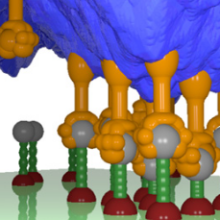Multiscale modeling of membrane adhesion
Cell recognition is a process involving many length and time scales. For instance, single molecule binding events drive the adhesion process on the length scale of a cell, bridging about 5 orders of magnitude (0.1 nm – 10um). In the time domain, nanosecond membrane fluctuations and the timescale of binder diffusion determines minutes-long growth of adhesion. To face the multiscale challenges, we set up a simulation scheme incorporating the fast membrane fluctuations into effective (un-)binding rates. We validate the simulation scheme with higher level Langevin simulations explicitly simulating membrane fluctuations. With this powerful multiscale simulation scheme, we simulated so far the adhesion process of biomimetic model systems (e. g. vesicles) and will, in future, aim at encompassing the full adhesion process of a biological cell.
Related publications
- First-Principle Coarse-Graining Framework for Scale-Free Bell-Like Association and Dissociation Rates in Thermal and Active Systems, J. Augustin Janeš, C. Monzel, D. Schmidt, R. Merkel, U. Seifert, K. Sengupta, and A.-S. Smith, Phys. Rev. X 12, 031030 (2022), Abstract, Download
- Signature of a non-harmonic potential as revealed from a consistent shape and fluctuation analysis of an adherent membrane, D. Schmidt, C. Monzel, T. Bihr, R. Merkel, U. Seifert, K. Sengupta, and A.-S. Smith, Phys. Rev. X 4, 021023 (2014), Abstract, Download
- Nucleation of ligand-receptor domains in membrane adhesion, T. Bihr, U. Seifert, and A.-S. Smith, Phys. Rev. Lett., 109, 258101 (2012), Abstract, Download
Adhesion to patterned Substrates
In this project, we study the stability of domains forming from bond lattices deforming the flexible membrane. Applying analytical and numerical methods, we predict stable and/or meta-stable bond configurations which are essential in the early stages of the inter-cellular adhesion. Continuing this idea, we study the behaviour of the flexible membrane while adhering to a pre-structured substrate. As the geometric structure is given, this model system provides the possibility to gain fundamental insight into physical properties of the membrane due to access from both the theoretical as well as the experimental side. On the theoretical side we are able to test well-established models and elaborated expansions of those models. The experimental results are provided from the labs of R. Merkel (Research Center Jülich) and K. Sengupta (University Marseille).
Related publications
- Signature of a nonharmonic potential as revealed from a consistent shape and fluctuation analysis of an adherent membrane, D. Schmidt, C. Monzel, T. Bihr, R. Merkel, U. Seifert, K. Sengupta, and A. Smith, Phys. Rev. X 4, 021023 (2014), Abstract, Download
- Coexistence of dilute and densely packed domains of ligand-receptor bonds in membrane adhesion, D. Schmidt, T. Bihr, U. Seifert, and A. Smith, EPL 99, 38003 (2012) , Abstract, Download
Quantitative comparison of theory with experiment
Stochastic displacements or fluctuations of biological membranes are increasingly recognized as an important aspect of many physiological processes, but hitherto their precise quantification in living cells was limited due to a lack of tools to accurately record them. A novel technique, called Dynamic Optical Displacement Spectroscopy (DODS), measures stochastic displacements of membranes with unprecedented combined spatio-temporal resolution of 20 nm and 10 μs. Now, fluctuating membranes of model membranes and membranes in living cells are measured and, due to the excellent temporal resolution, the full range of the temporal height-height auto-correlation function is obtained. Comparing to theoretical predicted temporal auto-correlation functions reveals physical properties of the membrane.
Related publications
- Nanometric thermal fluctuations of weakly confined bio-membranes measured with microsecond time-resolution, C. Monzel, D. Schmidt, U. Seifert, A.-S. Smith, R. Merkel, and K. Sengupta, Soft Matter 12, 4755-4768 (2016), Abstract, Download
- Measuring fast stochastic displacements of bio-membranes with dynamic optical displacement spectroscopy, C. Monzel, D. Schmidt, C. Kleusch, D. Kirchenbüchler, U. Seifert, A.-S. Smith, K. Sengupta, and R. Merkel, Nat. Commun., 6, 8162 (2015), Abstract, Download
Growth of adhesion domains
Understanding the dynamics of the formation of macromolecular structures in adherent membranes is key to a number of cellular processes as, e. g., immune response. We study the growth dynamics of these macromolecular structures, i. e. adhesion domains, between opposing membranes. The key players are thermal membrane fluctuations, membrane mediated correlations, complexation of binding molecules and diffusion of binders, leading to various scenarios and adhesion structures. By using advanced multiscale simulation schemes, we find different growth regimes, e. g. radial or ring-like growth of adhesion domains which have been observed in experiments. The mechanisms identified in our studies may shed light on the structuring of adhesion domains between two living cells.
Related publications
- Crowding of receptors induces ring-like adhesions in model membranes, D. Schmidt, T. Bihr, S. Fenz, R. Merkel, U. Seifert, K. Sengupta, and A.-S. Smith, BBA, Molecular Cell Research, 1853, 11B, 2984-2991 (2015), Abstract, Download
- Nucleation of ligand-receptor domains in membrane adhesion, T. Bihr, U. Seifert, and A.-S. Smith, Phys. Rev. Lett., 109, 258101 (2012), Abstract, Download
- Association rates of membrane-coupled cell adhesion molecules, T. Bihr, S. Fenz, E. Sackmann, R. Merkel, U. Seifert, K. Sengupta, and A.-S. Smith, Biophys. J.107, L33-L36 (2014), Abstract, Download
- Multiscale approaches to protein-mediated interactions between membranes - Relating microscopic and macroscopic dynamics in radially growing adhesions, T. Bihr, U. Seifert, and A.-S. Smith, New J. Phys. 17, 083016 (2015), Abstract, Download
- Two intertwined facets of adherent membranes: Membrane roughness and correlations between ligand-receptors bonds, E. Reister, T. Bihr, U. Seifert and A.-S. Smith, New J. Phys. 13, 025003 (2011), Abstract, Download






